

Compact Muon Solenoid
LHC, CERN
| CMS-SUS-14-022 ; CERN-EP-2016-225 | ||
| Search for electroweak production of charginos in final states with two $\tau$ leptons in pp collisions at $ \sqrt{s} = $ 8 TeV | ||
| CMS Collaboration | ||
| 16 October 2016 | ||
| JHEP 04 (2017) 018 | ||
| Abstract: Results are presented from a search for the electroweak production of supersymmetric particles in pp collisions in final states with two $\tau$ leptons. The data sample corresponds to an integrated luminosity between 18.1 fb$^{-1}$ and 19.6 fb$^{-1}$ at $ \sqrt{s} = $ 8 TeV, collected by the CMS experiment at the LHC. The observed event yields in the signal regions are consistent with the expected standard model backgrounds. The results are interpreted using simplified models describing the pair production and decays of charginos or $\tau$ sleptons. For chargino pair production, assuming that the third-generation sleptons are the lightest sleptons and that their masses lie midway between that of the chargino and the lightest neutralino, an excluded region in the plane of the neutralino mass vs. chargino mass is obtained. Chargino masses below 420 GeV are excluded at a 95% confidence level in the limit of a massless neutralino, and for neutralino masses up to 100 GeV, chargino masses up to 325 GeV are excluded at 95% confidence level. Constraints are also placed on the cross section for pair production of $\tau$ sleptons as a function of mass, assuming a massless neutralino. | ||
| Links: e-print arXiv:1610.04870 [hep-ex] (PDF) ; CDS record ; inSPIRE record ; CADI line (restricted) ; | ||
| Figures | |

png pdf |
Figure 1:
Schematic production of a $\tau $ lepton pair from slepton pair production. |
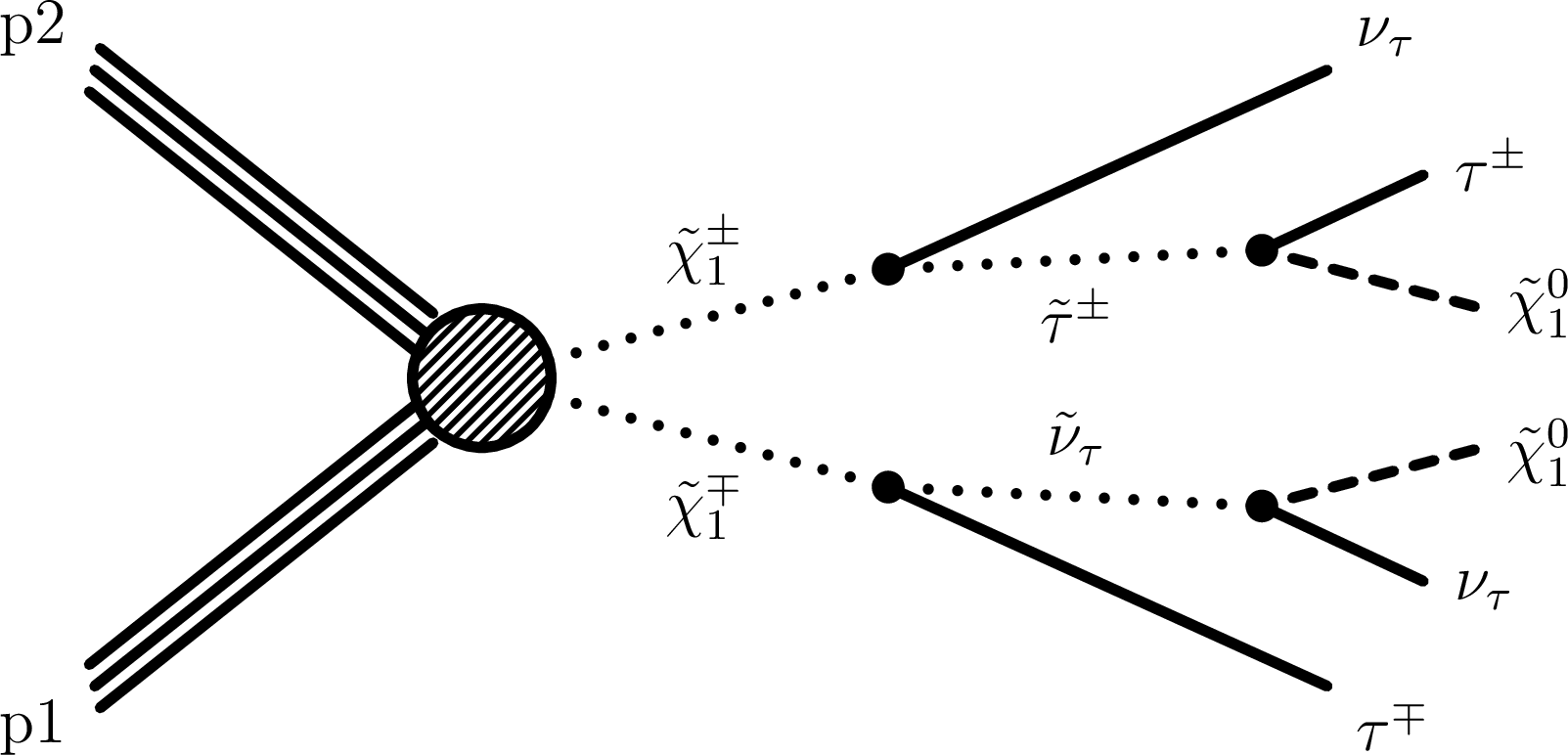
png pdf |
Figure 1-a:
Schematic production of a $\tau $ lepton pair from chargino pair production. |

png pdf |
Figure 1-b:
Schematic production of a $\tau $ lepton pair from slepton pair production. |

png pdf |
Figure 2:
The $ {{M_\mathrm { T2}}} $ distribution before applying the final selections on $ {{M_\mathrm { T2}}} $ and $ {M_\mathrm {T}^{ {\tau _\mathrm {h}} }} $, compared to SM expectation in the $ {\mu {\tau _\mathrm {h}} } $ channel. The signal distribution is shown for $m_{\tilde{\chi}^{\pm}_1 } = $ 380 GeV, $ m_{\tilde{\chi}^0_1 }= $ 1 GeV. The last bins include all overflows to higher values of $ {{M_\mathrm { T2}}} $. Only the statistical uncertainties are shown. |

png pdf |
Figure 2-a:
The $ {{M_\mathrm { T2}}} $ distribution before applying the final selections on $ {{M_\mathrm { T2}}} $ and $ {M_\mathrm {T}^{ {\tau _\mathrm {h}} }} $, compared to SM expectation in the $ {\mathrm{ e } {\tau _\mathrm {h}} } $ channel. The signal distribution is shown for $m_{\tilde{\chi}^{\pm}_1 } = $ 380 GeV, $ m_{\tilde{\chi}^0_1 }= $ 1 GeV. The last bins include all overflows to higher values of $ {{M_\mathrm { T2}}} $. Only the statistical uncertainties are shown. |
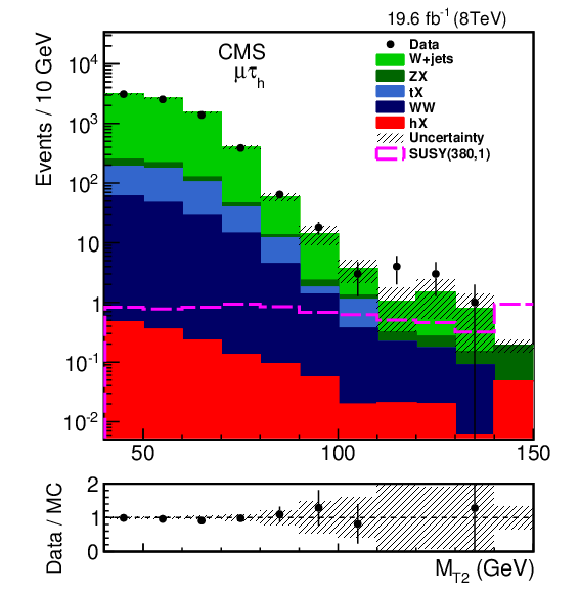
png pdf |
Figure 2-b:
The $ {{M_\mathrm { T2}}} $ distribution before applying the final selections on $ {{M_\mathrm { T2}}} $ and $ {M_\mathrm {T}^{ {\tau _\mathrm {h}} }} $, compared to SM expectation in the $ {\mu {\tau _\mathrm {h}} } $ channel. The signal distribution is shown for $m_{\tilde{\chi}^{\pm}_1 } = $ 380 GeV, $ m_{\tilde{\chi}^0_1 }= $ 1 GeV. The last bins include all overflows to higher values of $ {{M_\mathrm { T2}}} $. Only the statistical uncertainties are shown. |

png pdf |
Figure 3:
Schematic illustration of three control regions and the signal region used to estimate the QCD multijet background. |
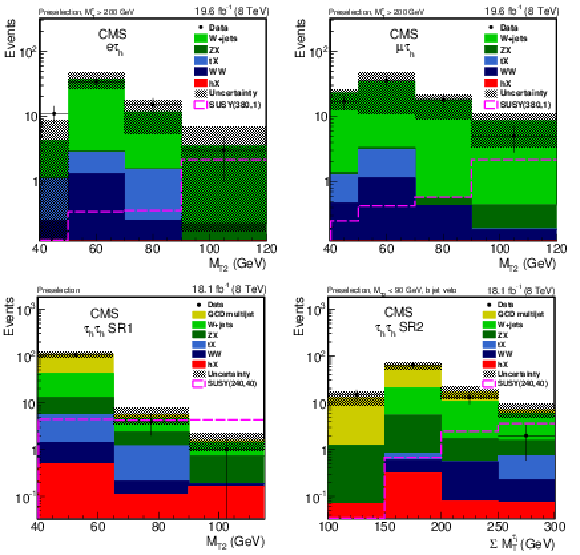
png pdf |
Figure 4:
The data yield is compared with the SM expectation. In different signal regions, when a background estimate from data is available, it is used instead of simulation, as described in the text. The signal distribution for a high $\Delta m$ scenario with ${m}_{\tilde{\chi}^{\pm}_1 } = $ 380 GeV and ${m}_{\tilde{\chi}^0_1 } = $ 1 GeV is compared with the yields of $ {\ell {\tau _\mathrm {h}} } $ channels while a scenario with lower $\Delta m$ (${m}_{\tilde{\chi}^{\pm}_1 } = $ 240 GeV and ${m}_{\tilde{\chi}^0_1 } =$ 40 GeV) is chosen for the comparison in $ { {\tau _\mathrm {h}} {\tau _\mathrm {h}} } $ channels. The higher values of $ {{M_\mathrm { T2}}} $ or ${\Sigma M_\mathrm {T}^{\tau _i}}$ are included in the last bins. The shown uncertainties include the quadratic sum of the statistical and systematic uncertainties. |
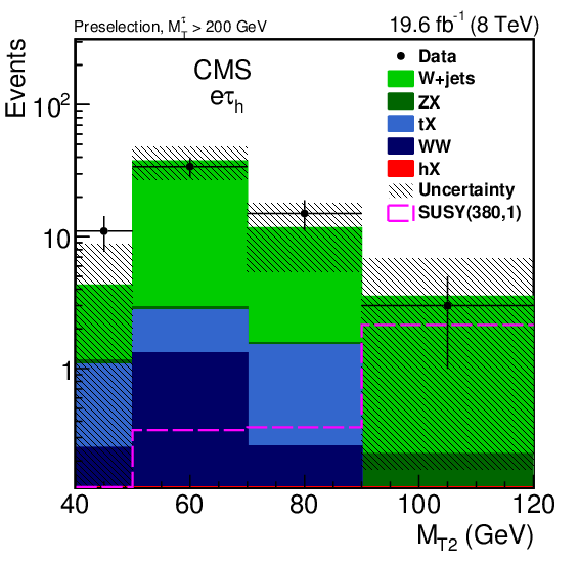
png pdf |
Figure 4-a:
The data yield is compared with the SM expectation. When a background estimate from data is available, it is used instead of simulation, as described in the text. The signal distribution for a high $\Delta m$ scenario with ${m}_{\tilde{\chi}^{\pm}_1 } = $ 380 GeV and ${m}_{\tilde{\chi}^0_1 } = $ 1 GeV is compared with the yields of the $ {\mathrm{e} {\tau _\mathrm {h}} } $ channel. The higher values of $ {{M_\mathrm { T2}}} $ are included in the last bin. The shown uncertainties include the quadratic sum of the statistical and systematic uncertainties. |
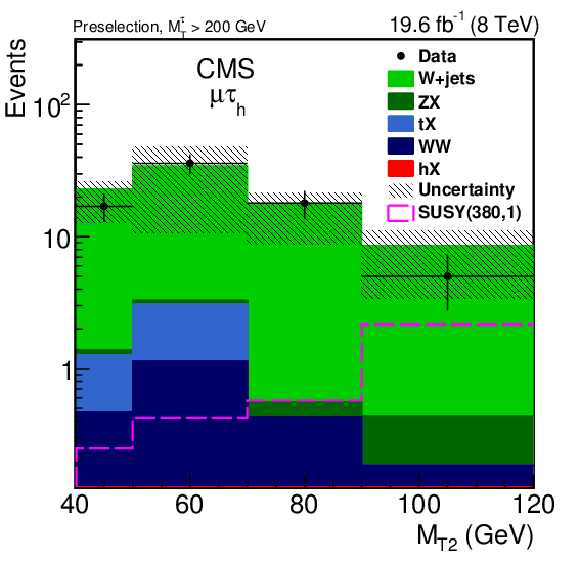
png pdf |
Figure 4-b:
The data yield is compared with the SM expectation. When a background estimate from data is available, it is used instead of simulation, as described in the text. The signal distribution for a high $\Delta m$ scenario with ${m}_{\tilde{\chi}^{\pm}_1 } = $ 380 GeV and ${m}_{\tilde{\chi}^0_1 } = $ 1 GeV is compared with the yields of the $ {\mu {\tau _\mathrm {h}} } $ channel. The higher values of $ {{M_\mathrm { T2}}} $ are included in the last bin. The shown uncertainties include the quadratic sum of the statistical and systematic uncertainties. |
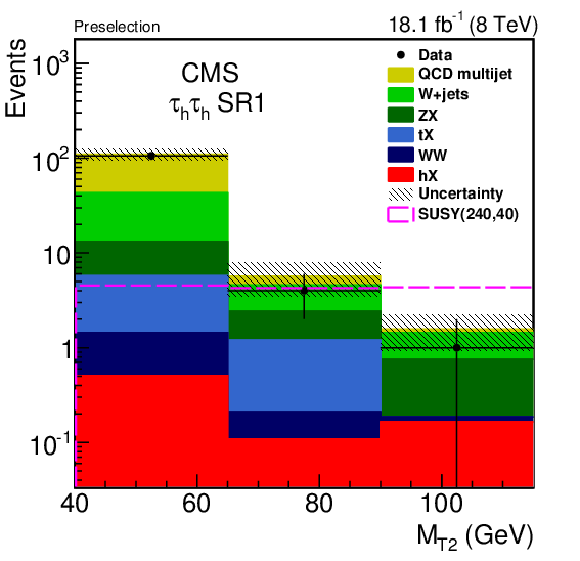
png pdf |
Figure 4-c:
The data yield is compared with the SM expectation. When a background estimate from data is available, it is used instead of simulation, as described in the text. The signal distribution for a low $\Delta m$ (${m}_{\tilde{\chi}^{\pm}_1 } = $ 240 GeV and ${m}_{\tilde{\chi}^0_1 } =$ 40 GeV) is chosen for the comparison in the $ { {\tau _\mathrm {h}} {\tau _\mathrm {h}} } $ channel (SR1). The higher values of $ {{M_\mathrm { T2}}} $ are included in the last bin. The shown uncertainties include the quadratic sum of the statistical and systematic uncertainties. |
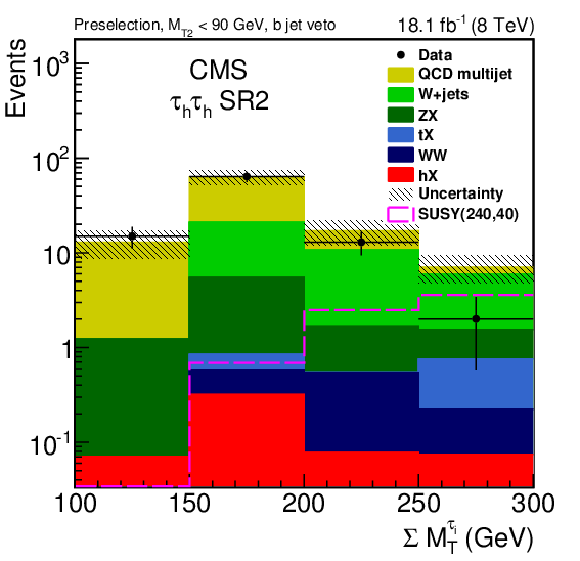
png pdf |
Figure 4-d:
The data yield is compared with the SM expectation. When a background estimate from data is available, it is used instead of simulation, as described in the text. The signal distribution for a low $\Delta m$ (${m}_{\tilde{\chi}^{\pm}_1 } = $ 240 GeV and ${m}_{\tilde{\chi}^0_1 } =$ 40 GeV) is chosen for the comparison in the $ { {\tau _\mathrm {h}} {\tau _\mathrm {h}} } $ channel (SR2). The higher values of ${\Sigma M_\mathrm {T}^{\tau _i}}$ are included in the last bin. The shown uncertainties include the quadratic sum of the statistical and systematic uncertainties. |
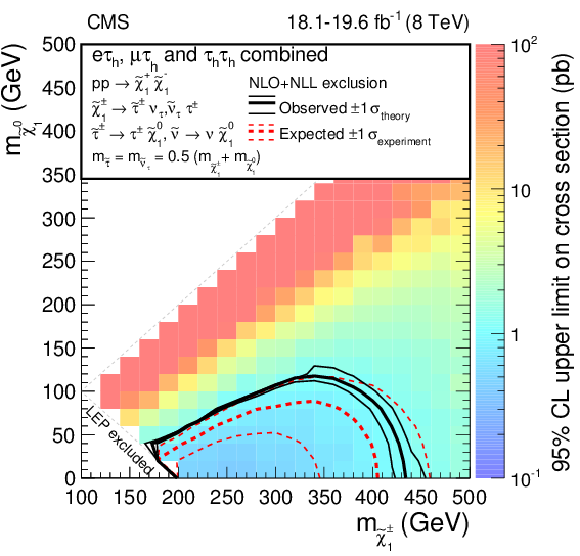
png pdf |
Figure 5:
Expected and observed exclusion regions in terms of simplified models of chargino pair production with the total data set of 2012. The triangle in the bottom-left corner corresponds to $\tilde{\tau}$ masses below 96 GeV, which has been excluded by the LEP experiments [67]. The expected limits and the contours corresponding to $\pm $1 standard deviation from experimental uncertainties are shown as red lines. The observed limits are shown with a black solid line, while the $\pm $1 standard deviation based on the signal cross section uncertainties are shown with narrower black lines. |

png pdf |
Figure 6:
Expected and observed exclusion regions in terms of simplified models in the $ { {\tau _\mathrm {h}} {\tau _\mathrm {h}} } $ channel. The conventions are the same as Fig. 5. |

png pdf |
Figure 7:
Upper limits at 95% confidence level on the left-handed $\tilde{\tau} $ pair production cross section in the $ { {\tau _\mathrm {h}} {\tau _\mathrm {h}} } $ channel. The mass of $\tilde{\chi}^0_1$ is 1 GeV. The best observed (expected) upper limit on the cross section is 43 (56) fb for $m_{\tilde{\tau} }= $ 150 GeV which is almost two times larger than the theoretical NLO prediction. |
| Tables | |
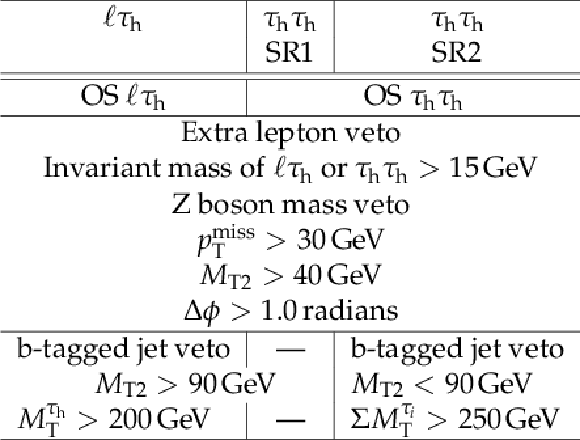
png pdf |
Table 1:
Definition of the signal regions. |

png pdf |
Table 2:
The estimated QCD multijet background event yields in the $ { {\tau _\mathrm {h}} {\tau _\mathrm {h}} } $ channel. The first two uncertainties are the statistical and systematic uncertainties of the method, and the last uncertainty is the extra systematic uncertainty due to the correlation assumptions. |

png pdf |
Table 3:
The W+jets background estimate in the two search regions. The systematic uncertainty ``syst'' comes from the maximum variation of the estimation found from varying the $ {\tau _\mathrm {h}} $ energy scale within its uncertainty. The ``shape'' uncertainty takes into account the difference between the shape of the search variable distribution in data and simulation. |

png pdf |
Table 4:
The DY background contribution estimated from simulation in four signal regions. The uncertainties are due to the limited number of MC events. |

png pdf |
Table 5:
Estimation of the misidentified $ {\tau _\mathrm {h}} $ contribution in the signal region of the $ {\ell {\tau _\mathrm {h}} } $ channels. The total systematic uncertainty is the quadratic sum of the individual components. All uncertainties are relative. The $r_\mathrm {m}$ ($r_\mathrm {g}$) is shorthand for misidentified (genuine) $ {\tau _\mathrm {h}} $ candidate rate. |

png pdf |
Table 6:
Summary of the systematic uncertainties that affect the signal event selection efficiency, DY and rare backgrounds normalization and their shapes. The sources that affect the shape are indicated by (*) next to their names. These sources are considered correlated between two signal regions of the $ { {\tau _\mathrm {h}} {\tau _\mathrm {h}} } $ analysis in the final statistical combination. |

png pdf |
Table 7:
Data yields and background predictions with uncertainties in the four signal regions of the search. The uncertainties are reported in two parts, the statistical and systematic uncertainties, respectively. The W+jets and QCD multijet main backgrounds are derived from data as described in Section 7; the abbreviation ``VV'' refers to diboson events. The yields for three signal points representing the low, medium, and high $\Delta m$ are also shown. SUSY(X, Y) stands for a SUSY signal with ${m}_{\tilde{\chi}^{\pm}_1 }= $ X GeV and ${m}_{\tilde{\chi}^0_1 } = $ Y GeV. |

png pdf |
Table 8:
Efficiencies to select a lepton or ${\tau _\mathrm {h}}$ in different channels. Here, $ {\tau _\mathrm {h}^1} $ and $ {\tau _\mathrm {h} ^2} $ stand for leading and subleading (in ${p_{\mathrm {T}}} $) ${\tau _\mathrm {h}}$ in the $ { {\tau _\mathrm {h}} {\tau _\mathrm {h}} } $ channel. Zero for the efficiency shows the region where the generated $\tau $ leptons do not pass the kinematical and geometrical selection cuts. |
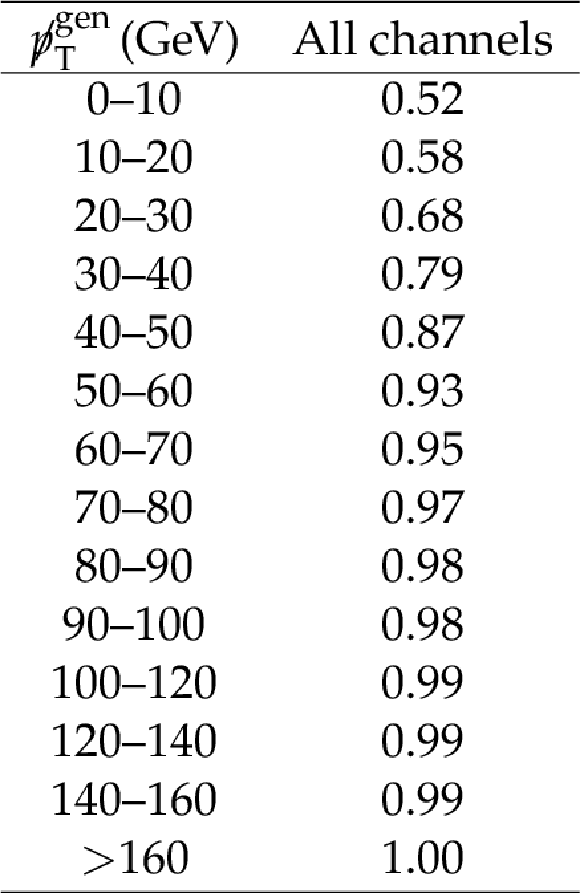
png pdf |
Table 9:
Efficiencies of the ${ {p_{\mathrm {T}}} ^\text {miss}}$ requirement in all channels versus ${ {p_{\mathrm {T}}} ^\text {gen} }$. |

png pdf |
Table 10:
Efficiencies of the invariant mass requirements in different channels versus generated mass. |
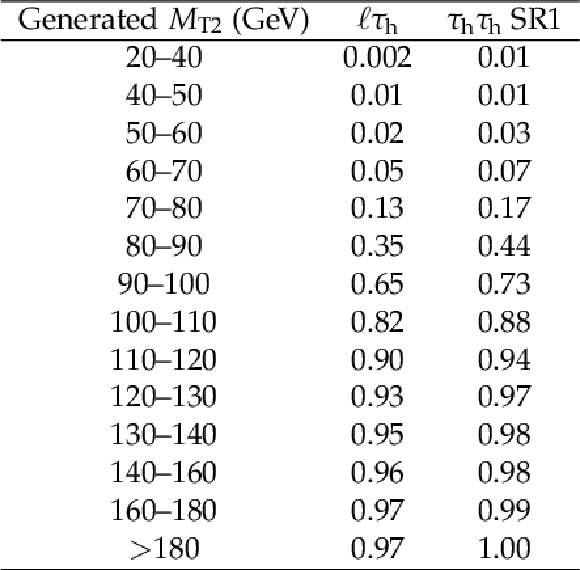
png pdf |
Table 11:
Efficiencies of the $ {{M_\mathrm { T2}}} > $ 90 GeV requirement in all channels versus generated $ {{M_\mathrm { T2}}} $. |

png pdf |
Table 12:
Efficiencies of the $ {M_\mathrm {T}^{ {\tau _\mathrm {h}} }} $ requirement in $\ell {\tau _\mathrm {h}} $ channels versus generated $ {M_\mathrm {T}^{ {\tau _\mathrm {h}} }} $. |

png pdf |
Table 13:
Efficiencies of the $ {{M_\mathrm { T2}}} $ requirement in $ { {\tau _\mathrm {h}} {\tau _\mathrm {h}} } $ SR2 versus generated $ {{M_\mathrm { T2}}} $. Zero for the efficiency shows the region that the generated $ {{M_\mathrm { T2}}} $ is much greater than the selection cut. |

png pdf |
Table 14:
Efficiencies of the ${\Sigma M_\mathrm {T}^{\tau _i}}$ requirement in $ { {\tau _\mathrm {h}} {\tau _\mathrm {h}} } $ SR2 versus the generated ${\Sigma M_\mathrm {T}^{\tau _i}}$. |
| Summary |
| A search for SUSY in the $\tau\tau$ final state has been performed where the $\tau$ pair is produced in a cascade decay from the electroweak production of a chargino pair. The data analyzed were from pp collisions at $\sqrt{s} = $ 8 TeV collected by the CMS detector at the LHC corresponding to integrated luminosities between 18.1 and 19.6 fb$^{-1}$. To maximize the sensitivity, the selection criteria are optimized for ${{\tau_\mathrm{h}} {\tau_\mathrm{h}} } $ (small $\Delta m$), ${{\tau_\mathrm{h}} {\tau_\mathrm{h}} } $ (large $\Delta m$), and ${\ell{\tau_\mathrm{h}} } $ channels using the variables ${{M_\mathrm{ T2}}}$, ${M_\mathrm{T}^{{\tau_\mathrm{h}} }}$, and ${\Sigma M_\mathrm{T}^{\tau_i}}$. The observed number of events is consistent with the SM expectations. In the context of simplified models, assuming that the third generation sleptons are the lightest sleptons and that their masses lie midway between that of the chargino and the neutralino, charginos lighter than 420 GeV for a massless neutralino are excluded at a 95% confidence level. For neutralino masses up to 100 GeV, chargino masses up to 325 GeV are excluded at a 95% confidence level. Upper limits on the direct $\tilde{\tau}\tilde{\tau}$ production cross section are also provided, and the best limit obtained is for the massless neutralino scenario, which is two times larger than the theoretical NLO cross sections. |
| References | ||||
| 1 | Y. A. Golfand and E. P. Likhtman | Extension of the algebra of Poincare group generators and violation of P invariance | JETP. Lett. 13 (1971)323 | |
| 2 | J. Wess and B. Zumino | A Lagrangian model invariant under supergauge transformations | PLB 49 (1974) 52 | |
| 3 | J. Wess and B. Zumino | Supergauge transformations in four-dimensions | Nucl. Phys. B 70 (1974) 39 | |
| 4 | P. Fayet | Spontaneously broken supersymmetric theories of weak, electromagnetic and strong interactions | PLB 69 (1977) 489 | |
| 5 | G. R. Farrar and P. Fayet | Phenomenology of the production, decay, and detection of new hadronic states associated with supersymmetry | PLB 76 (1978) 575 | |
| 6 | CMS Collaboration | Search for new physics in events with same--sign dileptons and jets in pp collisions at $ \sqrt{s} = $ 8 TeV | JHEP 01 (2014) 163 | CMS-SUS-13-013 1311.6736 |
| 7 | CMS Collaboration | Search for supersymmetry in hadronic final states with missing transverse energy using the variables $ \alpha_T $ and b-quark multiplicity in pp collisions at $ \sqrt{s} = $ 8 TeV | EPJC 73 (2013) 2568 | CMS-SUS-12-028 1303.2985 |
| 8 | CMS Collaboration | Search for anomalous production of events with three or more leptons in pp collisions at $ \sqrt{s} = $ 8 TeV | PRD 90 (2014) 032006 | CMS-SUS-13-002 1404.5801 |
| 9 | CMS Collaboration | Search for new physics in the multijet and missing transverse momentum final state in proton-proton collisions at $ \sqrt{s} = $ 8 TeV | JHEP 06 (2014) 055 | CMS-SUS-13-012 1402.4770 |
| 10 | CMS Collaboration | Searches for supersymmetry using the $ M_{\mathrm{T2}} $ variable in hadronic events produced in pp collisions at 8 TeV | JHEP 05 (2015) 078 | CMS-SUS-13-019 1502.04358 |
| 11 | CMS Collaboration | Search for physics beyond the standard model in events with two leptons, jets, and missing transverse momentum in pp collisions at $ \sqrt{s} = $ 8 TeV | JHEP 04 (2015) 124 | CMS-SUS-14-014 1502.06031 |
| 12 | ATLAS Collaboration | ATLAS Run 1 searches for direct pair production of third-generation squarks at the Large Hadron Collider | EPJC 75 (2015) 510 | 1506.08616 |
| 13 | ATLAS Collaboration | Summary of the searches for squarks and gluinos using $ \sqrt{s} = $ 8 TeV pp collisions with the ATLAS experiment at the LHC | JHEP 10 (2015) 054 | 1507.05525 |
| 14 | ATLAS Collaboration | Search for direct production of charginos and neutralinos in events with three leptons and missing transverse momentum in $ \sqrt{s} = $ 8 TeV pp collisions with the ATLAS detector | JHEP 04 (2014) 169 | 1402.7029 |
| 15 | ATLAS Collaboration | Search for direct production of charginos, neutralinos and sleptons in final states with two leptons and missing transverse momentum in pp collisions at $ \sqrt{s} = $ 8 TeV with the ATLAS detector | JHEP 05 (2014) 071 | 1403.5294 |
| 16 | CMS Collaboration | Searches for electroweak production of charginos, neutralinos, and sleptons decaying to leptons and W, Z, and Higgs bosons in pp collisions at 8 TeV | EPJC 74 (2014) 3036 | CMS-SUS-13-006 1405.7570 |
| 17 | CMS Collaboration | Searches for electroweak neutralino and chargino production in channels with Higgs, Z, and W bosons in pp collisions at 8 TeV | PRD 90 (2014) 092007 | CMS-SUS-14-002 1409.3168 |
| 18 | CMS Collaboration | Search for supersymmetry in the vector boson fusion topology in proton-proton collisions at $ \sqrt{s} = $ 8 TeV | JHEP 11 (2015) 189 | CMS-SUS-14-005 1508.07628 |
| 19 | S. P. Martin | A supersymmetry primer | hep-ph/9709356 | |
| 20 | ATLAS Collaboration | Search for the direct production of charginos, neutralinos and staus in final states with at least two hadronically decaying taus and missing transverse momentum in pp collisions at $ \sqrt{s} = $ 8 TeV with the ATLAS detector | JHEP 10 (2014) 96 | 1407.0350 |
| 21 | J. Alwall, P. Schuster, and N. Toro | Simplified models for a first characterization of new physics at the LHC | PRD 79 (2009) 075020 | 0810.3921 |
| 22 | D. Alves et al. | Simplified models for LHC new physics searches | JPG 39 (2011) 105005 | 1105.2838 |
| 23 | C. G. Lester and D. J. Summers | Measuring masses of semiinvisibly decaying particles pair produced at hadron colliders | PLB 463 (1999) 99 | hep-ph/9906349 |
| 24 | A. Barr, C. Lester, and P. Stephens | $ M_{\mathrm{T2}}: $ The truth behind the glamour | JPG 29 (2003) 2343 | hep-ph/0304226 |
| 25 | CMS Collaboration | The CMS experiment at the CERN LHC | JINST 3 (2008) S08004 | CMS-00-001 |
| 26 | CMS Collaboration | The CMS trigger system | Submitted to JINST | CMS-TRG-12-001 1609.02366 |
| 27 | CMS Collaboration | Particle-flow event reconstruction in CMS and performance for jets, taus, and MET | CDS | |
| 28 | CMS Collaboration | Commissioning of the Particle-flow event reconstruction with the first LHC collisions recorded in the CMS detector | CDS | |
| 29 | M. Cacciari, G. P. Salam, and G. Soyez | The anti-$ k_t $ jet clustering algorithm | JHEP 04 (2008) 063 | 0802.1189 |
| 30 | CMS Collaboration | Determination of jet energy calibration and transverse momentum resolution in CMS | JINST 6 (2011) P11002 | CMS-JME-10-011 1107.4277 |
| 31 | M. Cacciari and G. P. Salam | Pileup subtraction using jet areas | PLB 659 (2008) 119 | 0707.1378 |
| 32 | CMS Collaboration | Identification of b-quark jets with the CMS experiment | JINST 8 (2013) P04013 | CMS-BTV-12-001 1211.4462 |
| 33 | CMS Collaboration | Reconstruction and identification of $ \tau $ lepton decays to hadrons and $ \nu_{\tau} $ at CMS | JINST 11 (2016) P01019 | CMS-TAU-14-001 1510.07488 |
| 34 | CMS Collaboration | Search for neutral MSSM Higgs bosons decaying to a pair of tau leptons in pp collisions | JHEP 10 (2014) 160 | CMS-HIG-13-021 1408.3316 |
| 35 | P. M. Nadolsky et al. | Implications of CTEQ global analysis for collider observables | PRD 78 (2008) 013004 | 0802.0007 |
| 36 | T. Sjostrand, S. Mrenna, and P. Skands | PYTHIA 6.4 physics and manual | JHEP 05 (2006) 026 | hep-ph/0603175 |
| 37 | J. Alwall et al. | MadGraph 5: going beyond | JHEP 06 (2011) 128 | 1106.0522 |
| 38 | P. Nason | A new method for combining NLO QCD with shower Monte Carlo algorithms | JHEP 11 (2004) 040 | hep-ph/0409146 |
| 39 | S. Frixione, P. Nason, and C. Oleari | Matching NLO QCD computations with parton shower simulations: the POWHEG method | JHEP 11 (2007) 070 | 0709.2092 |
| 40 | S. Alioli, P. Nason, C. Oleari, and E. Re | NLO single top production matched with shower in POWHEG: s- and t-channel contributions | JHEP 09 (2009) 111 | 0907.4076 |
| 41 | S. Alioli, P. Nason, C. Oleari, and E. Re | A general framework for implementing NLO calculations in shower Monte Carlo programs: the POWHEG BOX | JHEP 06 (2010) 043 | 1002.2581 |
| 42 | CMS Collaboration | Measurement of the top quark mass using proton-proton data at $ \sqrt{s} $ = 7 and $ 8 TeV | PRD 93 (2016) 072004 | CMS-TOP-14-022 1509.04044 |
| 43 | ATLAS and CMS Collaboration | Combined measurement of the Higgs boson mass in pp collisions at $ \sqrt{s} = $ 7 and 8 TeV with the ATLAS and CMS experiments | PRL 114 (2015) 191803 | 1503.07589 |
| 44 | N. Davidson et al. | Universal interface of TAUOLA: Technical and physics documentation | CPC 183 (2012) 821 | 1002.0543 |
| 45 | GEANT4 Collaboration | GEANT4 --- a simulation toolkit | NIMA 506 (2003) 250 | |
| 46 | CMS Collaboration | The fast simulation of the CMS detector at LHC | J. Phys. Conf. Ser. 331 (2011) 032049 | |
| 47 | K. Melnikov and F. Petriello | Electroweak gauge boson production at hadron colliders through $ O(\alpha^2_s) $ | PRD 74 (2006) 114017 | hep-ph/0609070 |
| 48 | R. Gavin, Y. Li, F. Petriello, and S. Quackenbush | W physics at the LHC with FEWZ 2.1 | CPC 184 (2013) 208 | 1201.5896 |
| 49 | M. Czakon and A. Mitov | Top++: A program for the calculation of the top pair cross-section at hadron colliders | CPC 185 (2014) 2930 | 1112.5675 |
| 50 | J. M. Campbell, R. K. Ellis, and C. Williams | Vector boson pair production at the LHC | JHEP 07 (2011) 018 | |
| 51 | B. Fuks, M. Klasen, D. R. Lamprea, and M. Rothering | Gaugino production in proton-proton collisions at a center-of-mass energy of 8 TeV | JHEP 10 (2012) 081 | 1207.2159 |
| 52 | B. Fuks, M. Klasen, D. R. Lamprea, and M. Rothering | Precision predictions for electroweak superpartner production at hadron colliders with Resummino | EPJC 73 (2013) 2480 | 1304.0790 |
| 53 | B. Fuks, M. Klasen, D. R. Lamprea, and M. Rothering | Revisiting slepton pair production at the Large Hadron Collider | JHEP 01 (2014) 168 | 1310.2621 |
| 54 | A. J. Barr and C. Gwenlan | The race for supersymmetry: Using $ M_{\mathrm{T2}} $ for discovery | PRD 80 (2009) 074007 | 0907.2713 |
| 55 | CDF Collaboration | Measurement of the $ W $ boson mass with the collider detector at Fermilab | PRD 64 (2001) 052001 | hep-ex/0007044 |
| 56 | D0 Collaboration | Improved $ W $ boson mass measurement with the D0 detector | PRD 66 (2002) 012001 | hep-ex/0204014 |
| 57 | CMS Collaboration | Measurement of the inclusive $ \mathrm{ Z } $ cross section via decays to tau pairs in pp collisions at $ \sqrt{s} = $ 7 TeV | JHEP 08 (2011) 117 | CMS-EWK-10-013 1104.1617 |
| 58 | CMS Collaboration | Performance of electron reconstruction and selection with the CMS detector in proton-proton collisions at $ \sqrt{s} = $ 8 TeV | JINST 10 (2015) P06005 | CMS-EGM-13-001 1502.02701 |
| 59 | CMS Collaboration | Performance of CMS muon reconstruction in pp collision events at $ \sqrt{s} = $ 7 TeV | JINST 7 (2012) P10002 | CMS-MUO-10-004 1206.4071 |
| 60 | CMS Collaboration | Measurement of inclusive W and Z boson production cross sections in pp collisions at $ \sqrt{s} = $ 8 TeV | PRL 112 (2014) 191802 | CMS-SMP-12-011 1402.0923 |
| 61 | TOTEM Collaboration | First measurement of the total proton-proton cross section at the LHC energy of $ \sqrt{s} = $ 7 TeV | Europhys. Lett. 96 (2011) 21002 | 1110.1395 |
| 62 | M. Botje et al. | The PDF4LHC Working Group Interim Recommendations | 1101.0538 | |
| 63 | CMS Collaboration | CMS luminosity based on pixel cluster counting-summer 2013 update | CMS-PAS-LUM-13-001 | CMS-PAS-LUM-13-001 |
| 64 | A. L. Read | Presentation of search results: The CLs technique | JPG 28 (2002) 2693 | |
| 65 | T. Junk | Confidence level computation for combining searches with small statistics | NIMA 434 (1999) 435 | hep-ex/9902006 |
| 66 | ATLAS Collaboration | Procedure for the LHC Higgs boson search combination in summer 2011 | CMS-NOTE-2011-005 | |
| 67 | LEP SUSY Working Group (ALEPH, DELPHI, L3, OPAL) | Report of the LEP SUSY Working Group 2004 | ||

|
Compact Muon Solenoid LHC, CERN |

|

|

|

|

|

|